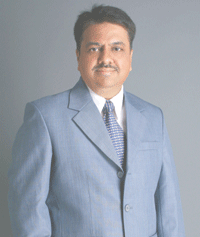 One of the several beneficial fallouts of the 30 million-strong (excluding Pakistan, Sri Lanka & Bangladesh) Indian diaspora, is the knowledge and learning inflow into the mother country which is assuming impressive proportions. A good example of this ‘reverse brain drain’ is Singapore-based Global Indian Foundation (estb. 2002), which has promoted the Global Indian International School (GIIS) chain of 15 schools stretching across six countries — Singapore, Malaysia, Australia, New Zealand, Japan and India. The foundation, which has drawn up an ambitious plan to multiply GIIS schools in India, is the transnational initiative of Singapore-based education entrepr-eneur Atul Temurnikar, an electronics and power engineering graduate of the Visveswariya Regional College of Engineering, Nagpur and former Singapore-based regional manager of HCL (1991-97) and IBM (1997-2001). “In Singapore children of the diaspora were experiencing great difficulties with the education system. They were caught between two incompatible systems,” recalls Temurnikar.
One of the several beneficial fallouts of the 30 million-strong (excluding Pakistan, Sri Lanka & Bangladesh) Indian diaspora, is the knowledge and learning inflow into the mother country which is assuming impressive proportions. A good example of this ‘reverse brain drain’ is Singapore-based Global Indian Foundation (estb. 2002), which has promoted the Global Indian International School (GIIS) chain of 15 schools stretching across six countries — Singapore, Malaysia, Australia, New Zealand, Japan and India. The foundation, which has drawn up an ambitious plan to multiply GIIS schools in India, is the transnational initiative of Singapore-based education entrepr-eneur Atul Temurnikar, an electronics and power engineering graduate of the Visveswariya Regional College of Engineering, Nagpur and former Singapore-based regional manager of HCL (1991-97) and IBM (1997-2001). “In Singapore children of the diaspora were experiencing great difficulties with the education system. They were caught between two incompatible systems,” recalls Temurnikar.
This was the stimulus behind the promotion of a culturally compatible school that would meet the aspirations of the Indian diaspora. Temurnikar quit his job as IBM’s country manager and roped in former diplomat, the late Dr. L.M. Singhvi and Justice C.S. Dharmadhikari to register the Global Indian Foundation in Singapore in 2002, which established its first K-12 school in Singapore at a capital cost of Rs.16 crore that very year. “Our heavy investment in infrastructure and high-quality faculty paid off very quickly with one of our students Apoorva Sachdeva scoring 45 out of 45 in the International Baccalaureate. We also give due attention to sports education — two of our boys are getting world class tennis coaching in Florida. But our distinguishing feature is the importance accorded to co-curricular education steeped in Indian culture,” says Temurnikar.
With the first GIIS school receiving excellent notice and word-of-mouth publicity, ethnic Indians across Asia began inviting Temurnikar to start schools in their countries. “We responded and today we have 14 schools in seven countries,” he says.
In India the foundation has already promoted schools in Trichi, Gandhidham and a tribal school in Tilakwada (Baroda) in collaboration with the Gujarat government. On the cards are 100 schools in the next ten years, of which 80 will be promoted in India. “When Dr. A.P.J. Kalam visited our school in Singapore in 2006, he challenged me to replicate it in rural India. While I was pondering the logistics of this proposition, the challenge was accepted by Dr. Singhvi and Prof. M.G.K. Menon who were driving the foundation as founding president and patron respectively. The consequence is that we are educating 250 tribal boys and girls in a small tribal location called Tilakwada, 65 km from Baroda in Gujarat. We are confident that one day they will rise to become acknowledged leaders of India,” vows Temurnikar.
Encouraged by the enthusiastic response to GIIS schools in India, expansion plans are on the drawing board. “We plan to promote 80 K-12 primary-cum-secondary schools in India over the next 10 years apart from 20 in other countries. Some of these schools will be funded by GIF and some co-promoted with local partners. My experience is that funding is never a problem where there is a good plan. The money follows,” says Temurnikar.
Right on!
Autar Nehru (Delhi)